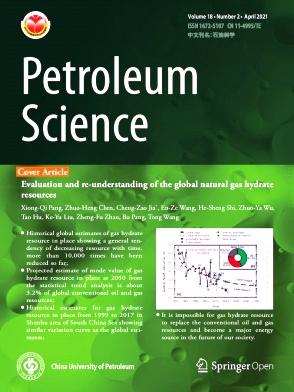Mechanism of proppant transport and deposition in rough intersecting fractures after offshore fracturing
IF 6
1区 工程技术
Q2 ENERGY & FUELS
引用次数: 0
Abstract
To accurately analyze proppant transport in rough intersecting fractures and elucidate the interaction mechanisms among liquid, particles, and rough walls, this study reconstructed a numerical model of fractures in inhomogeneous reservoirs with varying brittleness index (BI). Various auto-correlation Gaussian rough fracture models were created using Matlab to assess roughness through the fractal dimension method. This research innovatively combined Boolean operations to establish three-dimensional rough fracture models, incorporating (Computational Fluid Dynamics) CFD-DEM (Discrete Element Method) with a bidirectional method for cosimulation. The proppant transport in fractures was categorized into three zones based on the difference in the turbulent kinetic energy. Artificially induced fracture roughness increases fluid retention and turbulence, causing plugging effects and limiting proppant flow into branch fractures. Additionally, compared with the superior deposition and significant support effects of the spherical proppant, the low-sphericity proppant traveled farther under fracturing fluid, inducing more pronounced plugging near curved fracture intersections; the variation in fracture intersection angles primarily impacted the wall shear stress within the flow field, indicating smaller angles led to higher shear energy at the intersection. Compared with the intersection angle of 30°, the height and area deposited in the 90° branch fracture increased by 52.25% and 65.33%, respectively; notably, injecting proppant from smaller to larger particles (S:M:L) and a low velocity effectively ensured fracture conductivity near the wellbore at joint roughness coefficient (JRC) ≥46 while achieving satisfactory placement in the branch fracture, making it a recommended approach.
求助全文
约1分钟内获得全文
求助全文
来源期刊

Petroleum Science
地学-地球化学与地球物理
CiteScore
7.70
自引率
16.10%
发文量
311
审稿时长
63 days
期刊介绍:
Petroleum Science is the only English journal in China on petroleum science and technology that is intended for professionals engaged in petroleum science research and technical applications all over the world, as well as the managerial personnel of oil companies. It covers petroleum geology, petroleum geophysics, petroleum engineering, petrochemistry & chemical engineering, petroleum mechanics, and economic management. It aims to introduce the latest results in oil industry research in China, promote cooperation in petroleum science research between China and the rest of the world, and build a bridge for scientific communication between China and the world.
 求助内容:
求助内容: 应助结果提醒方式:
应助结果提醒方式:


